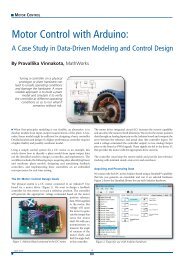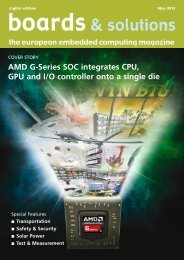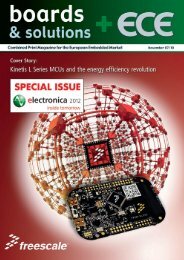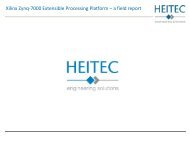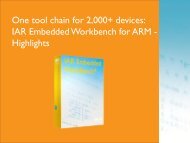Motor Control Lighting Development Tools Motor ... - ICC Media GmbH
Motor Control Lighting Development Tools Motor ... - ICC Media GmbH
Motor Control Lighting Development Tools Motor ... - ICC Media GmbH
Create successful ePaper yourself
Turn your PDF publications into a flip-book with our unique Google optimized e-Paper software.
TOOLS & SOFTWAREDesign reuse – managing dataand processesBy Rob Evans, AltiumDesign reuse offers manyadvantages but the problem isguaranteeing the integrityof reusable design data.This article describes a newapproach, in which designcontent is released intoa secure storage vault asa unique, traceable revision,also containing any numberof child elements such ascomponents and sub-circuits,maintaining integrity downto the lowest level. In electronics design the need to reuse assetshas grown increasingly insistent as productdevelopment becomes more complex and projecttimelines reduce. The efficiency advantagesof reduced design time and lower costs, andthe potential safety net of harnessing designelements of a known origin and quality, makedesign reuse a compelling concept. To makepractical design reuse a reality one of the keyfactors, most difficult to achieve, is assuringthe integrity of reusable design data – withoutit, the risk is too high and we don’t have theconfidence to reuse that design data. Becauseof that doubt, designers and organizations areunderstandably reluctant to take the risk oftackling real design reuse at anything but ahigh-cost enterprise level.Yet at its most fundamental level, design engineerspractice design reuse in every hardwareproject through the use of integrated circuits –off-the-shelf ICs that have been rigorouslytested and used in countless other designs. ICsgenerally contain a complex collection of circuitry,but we have faith in the integrity ofwhat’s inside. This example points to the essentialconcepts of effective design reuse. Here,the reapplied collection of electronics and datais a known and trusted commodity. There’sno need to reinvent the wheel by designing itsinternal circuitry, since we have full confidencein the integrity of the ‘pre-assembled’ version.And secondly, we aim for a disciplined approachto establishing, storing and using thedesign data associated with that reusable element,by rigidly using a formalized source(such as company database libraries) that featuresstandardized naming conventions anddata structures. It highlights two clues to practicaland effective design reuse – maintainingdesign data integrity and a disciplined approachto how that data is created and applied.In practice, the main challenge when reusingcomponents tends to be further down the designpath where we commit to the final stagesof releasing a design for prototyping or production.At this point we need to be confidentthat the component data is up-to-date and relevant,or more specifically, that a part is stillavailable, still cost-effective in numbers required,and not superseded by a more suitablecomponent.Managing the integrity of collections of components– ensuring their reuseability in effect– can take on the form of locally approvedcomponent libraries right through to companydatabase libraries that hook into the organization’slifecycle management system. The practicaleffectiveness of these systems varies widely– higher level, more complex and intrusivedata management tends to restrict componentchoice and is disconnected from the designprocess, while an informal, local approach carriesa higher degree of risk but is an interactivepart of the environment where componentdecisions are actually made.It’s at the highest level of design reuse wherethings really become challenging and our confidenceunderstandably wanes. The ultimateaim of recycling design resources is the abilityto confidently apply whole sections of pre-existingdesign content in new design projects –reusing our hard-won and painstakingly developeddesign IP. This is design reuse at amuch higher level of abstraction, where thenumber of elements and variables included ineach saved design package can be huge. Here,each reusable section will represent the circuitryand sub-elements – components (includingmodels and parameters), nested circuitry andso on – that are needed to deliver the functionof that package.To date, this level of design reuse has beentackled using an ad hoc approach based oncopy-and-paste techniques, or at best, a systemto formally store reusable chunks of circuitry.This notional design reuse capability providesthe basic mechanisms to implement reusableelements, but does very little (or nothing atall) to mitigate the risk of using them. You justcan’t be sure that the source circuitry is the latestversion, its functionality is still viable, itApril 2013 24




